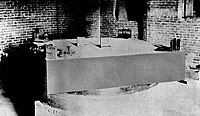
Photo from wikipedia
With the increased demand for hydrogen for carbon-neutral propulsion technologies, understanding the coupling effect of the fuel injection and cavity on flow characteristics is essential and an open issue for… Click to show full abstract
With the increased demand for hydrogen for carbon-neutral propulsion technologies, understanding the coupling effect of the fuel injection and cavity on flow characteristics is essential and an open issue for cavity-based hydrogen supersonic flame stabilization and optimizations. In this paper, the active subspace (AS) method is exploited to quantitatively reveal the intrinsic connections between the flow and flame stabilization with various fuel injection and cavity geometric parameters. A flame stabilization metric [Formula: see text] connecting the flame stabilization mode with nonreacting flows is proposed for the AS analysis and multiobjective optimizations. The results show that there exist one-dimensional active subspaces for key performance metrics, for example, the total pressure loss [Formula: see text], residence time [Formula: see text], and [Formula: see text]. The fuel injection pressure, cavity length-to-depth ratio, and cavity depth are three leading factors that govern the total pressure loss while the cavity residence time is dominated by the cavity depth. The proposed [Formula: see text] reasonably maps the flame stabilization mode with nonreacting flows. Using the response lines obtained by the AS, the tradeoff between [Formula: see text] and [Formula: see text] is quantitatively formulated with a clear visualization of candidate sets in the input space, demonstrating the advantages of the AS method for the combustor designs involving multiple objectives.
Journal Title: AIAA Journal
Year Published: 2023
Link to full text (if available)
Share on Social Media: Sign Up to like & get
recommendations!